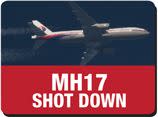MH17 probe a daunting task, say experts

Dutch-led crash investigators for flight MH17 will have to painstakingly reconstruct the shattered fuselage to know what shot it down, but only satellite images can say who pushed the button, experts said yesterday.
Evidence already points to an SA-11 surface-to-air missile having shot down the Malaysian Airlines 777 over rebel-held Ukrainian territory, killing all 298 people on board, 193 of them Dutch.
"The shrapnel damage on the airframe parts that's been seen so far is consistent with what you would expect to see from an SA-11 warhead exploding in close proximity," said Justin Bronk, analyst in Military Science at the Royal United Services Institute in London.
"But to get a conclusive answer you would have to take the aircraft away and completely reconstruct it as best as you could," he told AFP, as happened with the wreckage of Pan-Am flight 103 after it was blown up over Scotland in 1988.
The plane came down in a war zone on Thursday and while forensics experts tasked with identifying the bodies have arrived at the scene, those probing the cause of the crash are still in Kiev "for security reasons," the Dutch Safety Board leading the probe said.
Rebels, civilians and journalists have been walking all over the crash scene, handling objects, while observers from the Organisation for Security and Cooperation in Europe have said some pieces of wreckage have been sawn in half while on the ground.
Adding to the mammoth task, crash debris is spread over an area of around 35 square kilometres after the plane disintegrated at an altitude of 10,000 metres.
"Reassembling the wreckage could reveal some of the details the black box cannot reveal," said Gerry Soejatman, consultant with the Jakarta-based Whitesky Aviation chartered flight provider.
"These include an exact idea of which part was hit, and how the disintegration of the plane progressed in that short period of time after it was blown from the sky," he told AFP.
The Dutch Safety Board refused to say if or where the plane fuselage might be reconstructed.
"People tend to reduce air accident investigations to the black boxes. But while they're essential, they are not enough," said former test pilot and air crash investigator Robert Galan.
"For instance, in the case of a missile, examining the wreckage allows you to determine whether the impact came from in front or behind the plane," he told AFP.
But, he warned, it is essential for investigators to gain swift access to the site.
"If people have been walking over essential evidence for three days, you will never find it," Galan said.
Investigators will also be looking for pieces of shrapnel or traces of explosives from the missile, which likely exploded a few metres away from the plane to maximise damage.
"Explosive residue will presumably be present, in small quantities," which could help identify the type of missile, said Bronk.
"However, it is worth remembering, that this crash site does sit in an active war zone. So, there's potential for contamination by explosive residue from other munition sources in the area."
Pro-Russian separatists have been accused of firing a Russian-supplied missile, while Moscow says Kiev shot down the Boeing 777.
Alleged conversations between rebels discussing the shooting down, intercepted by intelligence agencies, as well as satellite images around the time of the crash will be key to identifying who ordered the attack and who pushed the button.
But, said Bronk, "the Russian and the separatist side will always just claim that it (conversation recording) is a fake."
"The really conclusive thing will be if eventually satellite imagery is released, showing exactly where the missile launcher was and fired. And also, crucially, where it went after that."
Washington, one of the first to suggest a surface-to-air missile was used, has said it is examining satellite imagery of the area.
"I don't see the black boxes being of much help in this case," said Soejatman. "It certainly won't tell us who shot the plane down."
But, said Ben Moores, aeronautical expert at IHS Jane's, the sound recordings on the black boxes, now in the hands of Malaysian authorities, could help prove what kind of missile was used.
"An air-to-air missile makes a small blast, while a ground-to-air missile makes a much bigger one," he said. – AFP, July 23, 2014.


